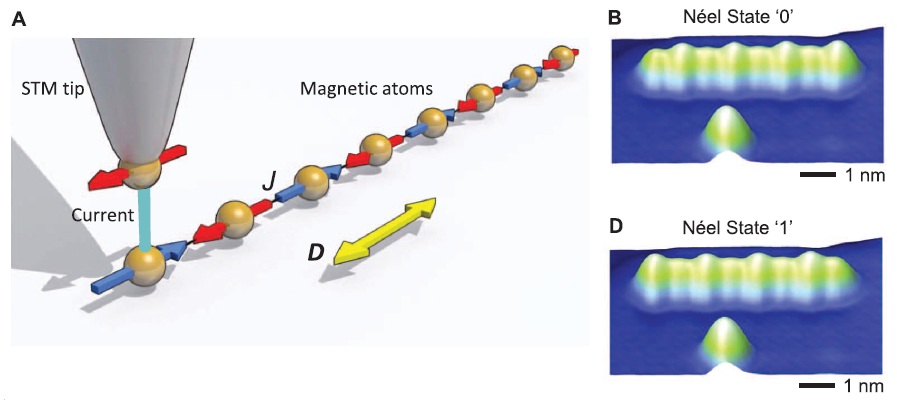
Information stored by a chain of magnetic atoms. Left: an STM tip measures the magnetic state of the iron atoms. Right: through increasing the current between tip and atoms the magnetic states can be switched. Peaks become valleys and vice versa. (c) Science Magazine
I now finally got the time to follow-up on last week’s paper in Science by Andreas Heinrich‘s group at IBM on magnetic storage elements that are only a few atoms in size. There have been a few misconceptions in some of the news reports with some being plainly wrong (‘smallest storage device ever made’), and many didn’t mention much about the scientific principles behind this study, although these are quite interesting. One of the better reports appeared in the New York Times, albeit again without going much into details. So I hope I can still add something useful with this blog post.
And actually, we’ve come across Andreas Heinrich’s previous research before, he does very innovative research with scanning tunneling microscopes (STM). In this latest Science paper he has now explored the limits of magnetic storage devices. Magnetism is of course the basis for storage such as magnetic hard drives. The problem in increasing the storage density in any magnetic storage device is that the magnetic regions begin to interfere with each other as they become smaller and are integrated closer together, because magnetic states on the order of just a couple of atoms are not very stable. […]
Continue reading...
The study of materials is one of the major areas of science, with legions of researchers in physics, chemistry and materials science working on this topic. Condensed matter physics is one of the largest research areas in physics. Yet, it makes me often uneasy how the benefits of materials science are promoted. It is all too often about applications, and not about fundamental physics. How materials such as graphene might revolutionize electronics. And how new physical concepts could be used to develop materials for energy applications: solar cells, batteries and so on. In classical materials science it’s often about tougher materials, such as enhanced steels, and less about the fundamental insights they are based on. Of course, applications are an important aspect in the study of materials. But does this mean that too often fundamental insights are neglected in favour of a material’s commercial potential?
[…]
Continue reading...

Optical switching might make computer hard drives faster. Photo by pobre.ch via flickr.
Magnetism remains the most developed way to store digital information. The giga and terabytes of computer hard drives as well as the magnetic stripes that still are used for credit cards or hotel room keys, all function with the help of magnetic fields. There, the direction of the magnetic fields, up or down, expresses the digital 0s and 1s that make up the computer bits and bytes.
As the amount of data we store on hard drives continues to increase, it is of course desirable that read and write speeds follow that trend. As far as writing data is concerned, however, switching the magnetisation is not that easy as all the individual magnetic fields of the majority of atoms that make up a bit, their so-called magnetic moment, has to be reversed. Given that these magnetic moments are interconnected through magnetic forces, such reversals aren’t very fast.
Modern hard drives manage to write about 1 billion bits per second. That’s a nanosecond per bit. In the lab, switching speeds are even faster, achieving hundreds of picoseconds to nanoseconds. But while this sounds like a pretty fast process, it is orders of magnitude slower than many other electronic processes in a crystal. Yet, magnets needn’t be that slow. What we have considered so far is switching magnetization by an external magnetic field, such as that generated in the write head of a hard drive. This isn’t the only possibility. If ultrashort optical laser pulses are used instead, magnetism can be switched a hundred times faster, on the order of a picosecond.
How does this work? In a paper published in advance on the Nature website this week, Ilie Radu, Theo Rasing from Radboud University in Nijmegen and others have investigated the details of the optical switching proceeds for a particular class of magnets, antiferromagnets.
[…]
Continue reading...




January 15, 2012
3 Comments